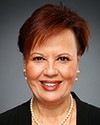Mr. Chair, thank you for the introductions of our team at the APA.
We appreciate the opportunity to be here with you today to speak about the special examination conducted by our colleagues at the Office of the Auditor General through late 2015 and early 2016. The APA is committed to ensuring that it delivers its mandate by the safest, most efficient means possible, all while remaining current within the ever-evolving marine industry and staying within the confines of the Pilotage Act. We welcome the opportunity for feedback, which ultimately improves our business processes. Therefore, we fully supported the OAG through a concerted effort and agree with the final outcome that is before you today.
Of the 10 recommendations, we are pleased to report that six are now completed, while the remaining four will be completed before the second quarter of 2017, in the next six to seven months.
I would like to provide a brief overview of the Atlantic Pilotage Authority with a slide show, which you also have copies of, I believe. It should be quick.
This was updated this year, 2016, as part of our plan. Our mission statement is to deliver safe, effective, and self-sustaining marine pilotage services in Atlantic Canada. Our objectives have also been redefined, but we'll move on to governance, the next slide. The authority has a representative board, with two members recommended by the marine industry, two recommended as pilotage representatives, and two named as public interest representatives. You can see the makeup of the board.
In the organization itself, as you can see from the org chart, there are 47 employee pilots, 17 pilot boat crew members, and six dispatchers. We do have 11 entrepreneurial pilots, as mentioned in the report, who provide services in a number of the smaller ports, representing about 7.5% of the traffic, or 630 assignments out of roughly 8,000.
The next slide shows the provinces inside our jurisdiction, which covers 17 compulsory areas, about 32,000 kilometres of coastline. Pilot transfer is very significant to us. We have rules, regulations, procedures, and safety equipment in place to ensure safe embarking and disembarking of the pilot. How a pilot gets to an assignment is through a fleet of robust, modern pilot boats. They are stable platforms, effective in rough weather, fast and manoeuvrable. They utilize integrated navigational equipment and have capable man-overboard retrieval systems. We own nine of them.
Some of the ships that call the east coast of Canada.... We pretty well get them all, from general cargo ships to container ships, auto carriers, foreign and domestic oil tankers, various types of cruise ships—which are getting bigger every year—and coastal tankers servicing the eastern parts of Canada.
Here, I draw your attention to some pretty significant milestones and indicators. In the last 10 years, which sort of covers the special exam period, 90,000 assignments were conducted. The incident-free rate was 99.93%. This rate always hovers between 99.93% and 99.96%. We've never released any pollutants in the waterways, and no injuries have occurred due to an incident while under pilotage.
Pilotage assignments where a pilot was delivered within one hour of confirmation time occurred 99.1% of the time, and for those that were delayed, the average delay was about 2.2 hours. Over 10 years, we've accumulated profits of about $1.9 million. We've launched four new pilot boats in this time, with a total cost of $13 million, and have $3.9 million outstanding in loans on these vessels today. We invested between $500,000 and $1 million annually in new equipment and vessel upgrades beyond the vessel purchases. That's pretty significant.
I won't get into the next slide, but we did a survey of our stakeholders and customers this year about satisfaction, safety, and our commitment to safety in public perception, and the response percentages, in green, are all in the eighties and nineties.
Then we move on to the special examination report. There were 10 recommendations, as I mentioned earlier. Under the category of corporate management practices, there were four recommendations. The authority has addressed these and implemented solutions. Under management of pilotage services, there were six recommendations; three of these will be addressed by the end of 2016, two more by March, and the final one by June.
In conclusion, our authority has a proven record of safety and efficiency, which contributes to public confidence and trust in Canada's marine industry, particularly with the transportation of crude oil to eastern Canadian refineries, terminals, and ports. The OAG has made 10 recommendations for the authority. The authority will have seven of these implemented by the end of 2016, and the remaining three in the first half of 2017.
I look forward to your questions.




